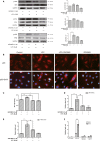Activation of liver X receptor attenuates lysophosphatidylcholine-induced IL-8 expression in endothelial cells via the NF-κB pathway and SUMOylation
- PMID: 27489081
- PMCID: PMC5134410
- DOI: 10.1111/jcmm.12903
Activation of liver X receptor attenuates lysophosphatidylcholine-induced IL-8 expression in endothelial cells via the NF-κB pathway and SUMOylation
Abstract
The liver X receptor (LXR) is a cholesterol-sensing nuclear receptor that has an established function in lipid metabolism; however, its role in inflammation is elusive. In this study, we showed that the LXR agonist GW3965 exhibited potent anti-inflammatory activity by suppressing the firm adhesion of monocytes to endothelial cells. To further address the mechanisms underlying the inhibition of inflammatory cell infiltration, we evaluated the effects of LXR agonist on interleukin-8 (IL-8) secretion and nuclear factor-kappa B (NF-κB) activation in human umbilical vein endothelial cells (HUVECs). The LXR agonist significantly inhibited lysophosphatidylcholine (LPC)-induced IL-8 production in a dose-dependent manner without appreciable cytotoxicity. Western blotting and the NF-κB transcription activity assay showed that the LXR agonist inhibited p65 binding to the IL-8 promoter in LPC-stimulated HUVECs. Interestingly, knockdown of the indispensable small ubiquitin-like modifier (SUMO) ligases Ubc9 and Histone deacetylase 4 (HDAC4) reversed the increase in IL-8 induced by LPC. Furthermore, the LPC-induced degradation of inhibitory κBα was delayed under the conditions of deficient SUMOylation or the treatment of LXR agonist. After enhancing SUMOylation by knockdown SUMO-specific protease Sentrin-specific protease 1 (SENP1), the inhibition of GW3965 was rescued on LPC-mediated IL-8 expression. These findings indicate that LXR-mediated inflammatory gene repression correlates to the suppression of NF-κB pathway and SUMOylation. Our results suggest that LXR agonist exerts the anti-atherosclerotic role by attenuation of the NF-κB pathway in endothelial cells.
Keywords: NF-κB; SUMOylation; liver X receptor; lysophosphatidylcholine.
© 2016 The Authors. Journal of Cellular and Molecular Medicine published by John Wiley & Sons Ltd and Foundation for Cellular and Molecular Medicine.
Figures





References
-
- Fuster V, Badimon L, Badimon JJ, et al The pathogenesis of coronary artery disease and the acute coronary syndromes (2). N Engl J Med. 1992; 326: 310–8. - PubMed
-
- Weber C, Noels H. Atherosclerosis: current pathogenesis and therapeutic options. Nat Med. 2011; 17: 1410–22. - PubMed
-
- Gerszten RE, Garcia‐Zepeda EA, Lim YC, et al MCP‐1 and IL‐8 trigger firm adhesion of monocytes to vascular endothelium under flow conditions. Nature. 1999; 398: 718–23. - PubMed
Publication types
MeSH terms
Substances
Grants and funding
LinkOut - more resources
Full Text Sources
Other Literature Sources
Miscellaneous

